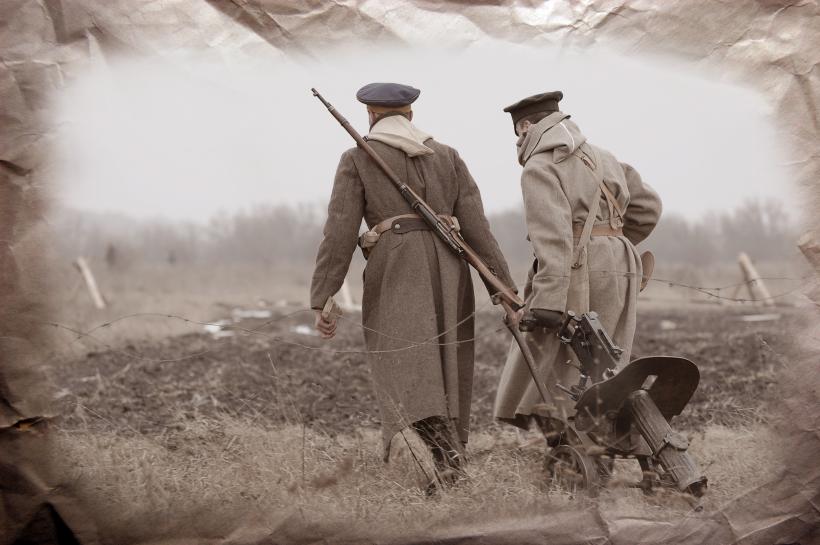
Thinkstock
This week marks the 100th anniversary of the outbreak of World War I—that grisly conflict that ushered the West into the era of modern warfare. To commemorate the Great War, YouTuber Emperor Tigerstar put together a time lapse video chronicling the territorial status of the Central and Allied Powers . . . every single day of the four year conflict. Hats off to you, Emperor Tigerstar. You must really know your way around early 20th century maps.
Various realities of the war are reflected in the timelapse—which we’ll get to—but there is one overwhelming take-away: For most of the conflict, there was essentially no territorial progress for either side. This, despite the fact that a staggering 16 million died during this case study in war stagnancy. The standstill created the need for dreaded trench warfare, that most emblematic feature of World War I, wherein soldiers would rot away in soggy mud and catch Spanish flu. Unless they got shelled or picked off in a typically-ill fated run on the enemy, that is.
Ok, let’s break down the First World War—timelapse style.
The War to End All Wars
After much saber-rattling and for reasons that are still rather unclear to the annals of history, the (perhaps pointless) conflict officially began on July 28, 1914 (with the Austro-Hungarian declaration of war on Serbia) and ended on November 11, 1918, less than a year after the U.S. entered the war (in which time, the Yanks still incurred more than 100,000 casualties). Here are four main points from the maps.
Point 1: West Stays Put
So you’ve probably heard of the Western Front echoing through the halls of popular culture. There’s the book, then movie, All Quiet on the Western Front; in fact, the front’s “Marginot Line” (a defensive line designed to protect the Eastern border of France from Germany) was so well-referenced it made it into the dictionary. Typically there is major emphasis on battles fought there—like Verdun and Somme—which even today are considered some of the "greatest" and bloodiest; it was the single worst day of casualties for British military in history, for example.
The Maginot Line, of course, is right where American soldiers entered the fray. Turns out the emphasis on the western terrain as the crux of the war may be misplaced however, since as the timelapse shows, it was incredibly static. That sucker barely budged the entire four years! Rare breakthroughs by either side involved very little real estate, and all the while millions of soldiers became casualties anyway.
Point 2: East is Where It’s At
The Eastern Front experienced some actual movement, in which Russia and Austria-Hungry duked it out in the first three years of the war. In 1916 it looked like the Russians might really do in the Kaiser and his only moderately anti-Semitic forces (catch that World War II foreshadowing?). But then the Russian Revolution enveloped that country in 1917, and they were out for the count.
Point 3: The Fighting Sprawl
The other area of territorial gains and losses? Non-European theaters, including Africa and the Middle East. Thoroughly mired in Europe after the first couple years of the war, the warring parties decided to take a fresh approach and attack each other’s colonies abroad (some of these colonies took the opportunity to rebel against their European taskmasters). This strategy had mixed results for all involved, but after some initial German successes, the Kaiserlings ultimately lost all their colonial claims. The rest went back to foreign repression as usual.
Point 4: Germany’s Counter-Intuitive Demise
Toward the end of the timelapse, it starts looking real bad for the Allies. The sniveling Central Powers enjoy a last-minute land grab that would seem to reflect winning momentum. And then they surrender. As Emperor Tigerstar put it, this sudden outcome “shows how fragile the war made these countries by bleeding themselves dry.” Austria-Hungry just didn’t have any more gas in the tank at that point—economically, politically or socially.
Ultimately, the timelapse demonstrates the horrific realities that can be brought on by excessive patriotism: Staggering casualties over years of fighting in the face of so little war progress.
Another takeaway from the war's outcome? Don’t screw the losers so hard that they drum up Hitler and return to the world stage cruising for a bruising two decades later. But that’s for another timelapse to show.






